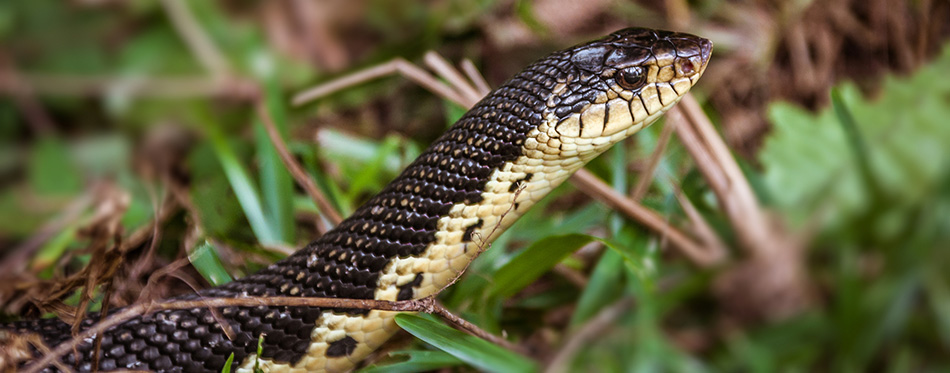With over 20 different types of poisonous snakes in the US, the threat of a snake bite on your dog can be a concerning issue, especially if you often walk your pooch in areas where one of these reptiles are known to live. And although not all snakes in the US have deadly venom, a dog snake bite can leave your pooch poorly, in pain, and distressed.
The best way to protect your pet from the risk of a snake bite is to avoid them in the first place but with a curious, energetic pup out on a walk, sometimes this is easier said than done. We give you the lowdown on snake bites on dogs, the essentials you need to know, and what to do if your pooch gets bitten.

How Big is the Risk of a Snake Biting My Dog?
Depending on where you live, there is a chance your dog could encounter a snake – whether that’s on their daily walk, out on the trail or even in their own back yard. And while not all species of snake are poisonous, a bite from a snake can at the very least be a distressing experience for your pet…and you. And your dog can still be bitten by a non-venomous snake and be at risk of infection even if the snake is not a poisonous type.
Where you live in the country, the places your pooch frequents and the time of the year you are out and about will all determine the level of risk of a snake bite on dog scenario. Snakes also like to hide and so tend to be found in areas of tall grass and undergrowth, while warmer weather could well bring out these shy reptiles as they look for water, warmth and food.
Which Snakes are the Most Dangerous to My Pet?
There are around 20 venomous and potentially deadly snakes in the US, which includes 16 types of rattlesnake, two species of coral snakes, one of cottonmouth (or water moccasin snake) and one species of copperhead. It does depend on where you live, but there is likely to be at least one type of deadly snake in every state, with the exception of Alaska.
The risk to life of your pet really depends on the type of snake that has bitten them and bites from the following reptiles need immediate attention otherwise can prove fatal.
Rattlesnake: Also known as pit vipers, these snakes typically live in the south eastern states and are usually brown or reddish in color and the familiar rattle on the end of their tail. They have cat-like slit eyes and a pair of fangs in the upper jaw.
Cottonmouth: Or water moccasin snakes have a particularly venomous bite, that can prove fatal. They are most commonly found in marshes, swamps and warm streams or lakes and are dark brown or black. The cottonmouth moniker comes from the white insides of their mouth.
Coral snake: Particularly venomous, the coral snake can be identified by its banded body, vividly colored red, yellow, white, and black. It also has a small, black-nosed head and can are nocturnal so human or dog bites are thankfully rare.
Copperhead: Typically found along the eastern coast, from New York to Nebraska, copperheads are a red-brown snake with a distinctive copper-colored head. Growing up to four feet in length, they are often found in leafy areas and hiding in woodpiles. A copperhead snake bite dog reaction is less toxic than a bite from a rattlesnake or cottonmouth.
If you are unsure whether you live in an area frequented by venomous snakes, then check out the website Venombyte.
Even if a snake is not poisonous, they can still give your pooch a bite. The difference between venomous and non-venomous snakes is in their mouth. Venomous snakes have fangs which release the venom into your pet’s bloodstream while non-poisonous snakes have rows of teeth. These teeth do not release venom but can break the skin and cause an infection if not treated.
What Does a Snake Bite Look Like on a Dog?
Thankfully, the thick fur of your pooch could well help to protect them from the worst of a snake bite, however, their coat could also make it difficult for you to find a potential bite site and identify whether the snake was venomous or not. The first indication that your dog has been bitten is actually seeing the snake itself, so when out with your dog in locations where snakes could be present, it’s essential to always keep your pet supervised and within easy reach. Physically seeing the snake in question can go a long way in understanding the severity of the bite and the repercussions for your pet.
The bite site will also tell you a great deal – a non-poisonous snake will still leave bites marks on your dog’s skin, but it won’t be punctured whereas a venomous snake will leave those tell-tale puncture marks as they sink in their fangs.
Snake Bite Symptoms in Dogs
Depending on whether your dog has been bitten by a venomous or non-poisonous snake, there will be a host of symptoms you need to look out for and respond to as quickly as you can. Depending on the snake type, some symptoms will be immediate while others may take between one and 24 hours to fully manifest.
Physical symptoms that your dog has been bitten by a snake include:
- Localized damage to the skin, including swelling, discoloration and bruising, bleeding
- Signs of physical pain and distress
Then, as the venom takes effect, you could see the following in your dog:
- Shaking, tremors, muscle twitching and rapid breathing
- Sudden weakness and collapse
- Excessive salivation, nausea and vomiting
- Dilated pupils and difficulty in blinking
- Loss of bladder and bowel control
- Blood in the urine
Later stages – without treatment
- Paralysis, coma, death

What to do if you Think Your Dog Has Been Bitten
If you know – or suspect – your dog has been bitten by a snake, time is of the essence, especially if you believe the snake is venomous. But the key to helping your pooch is to keep calm so that your dog doesn’t panic. Your main goal is to get your pet to the veterinary clinic as soon as possible without any unnecessary delay so he can get the urgent treatment he needs. Depending on the snake bite and the level of poison, your pet will need to be treated, potentially with an anti-venom, as soon as possible.
Try to avoid dealing with the bite yourself, as this can delay essential treatment. However, you should look to do the following:
- Stay calm, and keep your dog calm as you can
- Place your pet in a carrier or confined space in your car if you can to keep him immobile and to help reduce the movement of the venom around his body
- Wherever possible, keep the location of the bite below heart level
- If your dog has been bitten on the neck or head, remove his collar as the site may start to swell
- If your nearest vet is some distance away, then the best dog snake bite home treatment is to apply a pressure bandage to the bite site – this can slow the movement of the venom to the heart
- Other home remedies for snake bites on dogs such as ice packs, tourniquets, wound cleaning or even trying to suck out the venom are not necessary and can waste valuable time in getting your pet treated
- If you can, make a note of the snake if you saw it or it is still nearby – if you don’t know the type, the coloration and markings can really help your vet identify the snake and ensure your dog gets the most appropriate treatment
- Do not go anywhere near the snake or try to catch or kill it. Leave well alone, keep your personal safety and the swift treatment of your pet as your top priority.
Related Post: Dog Carrier Slings
Treatment for Snake Bites
Once at the veterinary clinic, you will need to give the vet as much information as you can, including what you saw or know about the snake and roughly what time your pooch was bitten. If it was a poisonous snake, your pet will most likely need to be given an anti-venom, or antivenin, which is a commercially made serum that can neutralize the effect of the snake bite. However, some antivenin is specific to the type of snake so the more information you can give the medical team, the more accurate your pet’s treatment will be.
After a thorough examination, your vet will administer the antivenin if appropriate, as well as treatment for other symptoms that have manifested, such as pain, localized swelling and potential infection as well as re-hydration if required.
Depending on the severity of the bite, and the time elapsed since the snake encounter, your pet may well also need additional supportive and intensive care. It usually takes two-four days for a dog to recover from most snake bites, as long as it received prompt and appropriate treatment. However, some animals may take longer to get back onto the road to recovery due to internal tissue and organ damage, so the sooner you get your dog treated after a snake bite, the better.

How to Prevent a Snake Bite
When it comes to treating a snake bite in a dog, prevention is better than the cure and there are many things you can do to reduce the risk of your pet falling foul of a snake when out and about:
- Keep the grass in your garden neat and short, and your back yard and wood piles tidy and free of places where a snake can choose to hang out
- Clean up any spilt food or food waste in your garden that could attract rodents…and predatory snakes
- When out with your dog, especially in ‘snake risk’ areas when hiking, etc, keep him on a leash and always stick to the trail. Take a look at our review of the best dog leashes for more options.
- Avoid tall grasses, swampy areas, beach dunes, large bushes, and rocks when walking your dog and always ensure your pooch is in sight at all times
And finally, do your homework if you think you live in a snake zone’ and know what snakes are common where you live, if any are venomous and what type they are so that should your pooch be bitten by a snake you will be able to act appropriately right away.

